Flat Trigger vs Curved: 5 Parameters Based Ultimate Comparison
The smallest details can significantly impact an individual’s shooting experience on a firearm. Among these details, the choice between a flat trigger vs curved one has sparked considerable debate among shooting enthusiasts, competitive shooters, and self-defense practitioners.
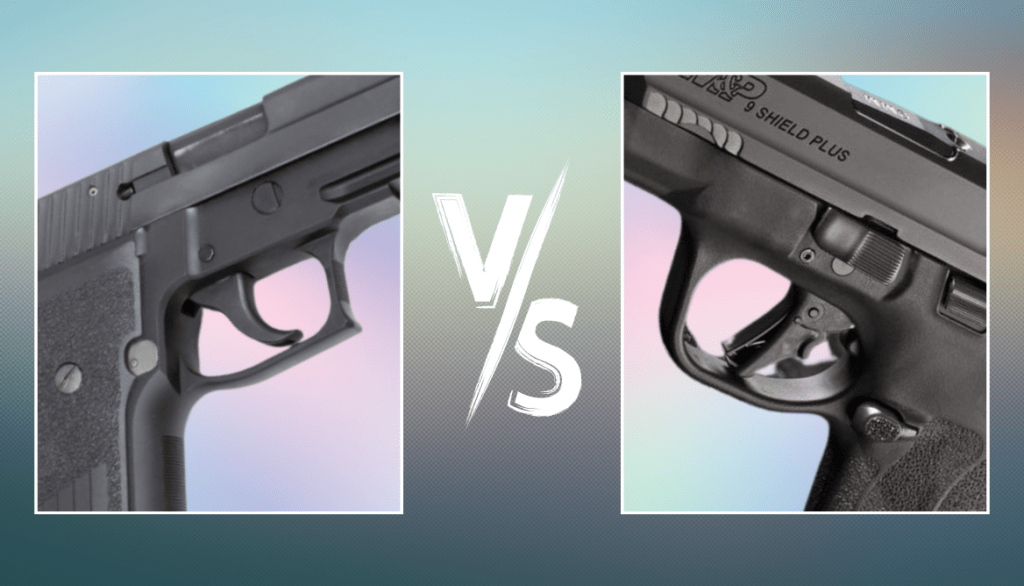
Our comprehensive analysis of both triggers delves into key similarities and differences between both triggers, Pros and cons, Range time, and key applications. We will also examine the trigger shape’s effect on ergonomics, finger placement, trigger control, precision, and overall shooting experience.
By examining these factors, you will understand each trigger design’s benefits and make an informed decision based on your shooting preferences and needs.
The Trigger Guard: Key Features
The trigger is a critical component of a firearm, responsible for initiating the firing sequence by igniting the primer in the cartridge.
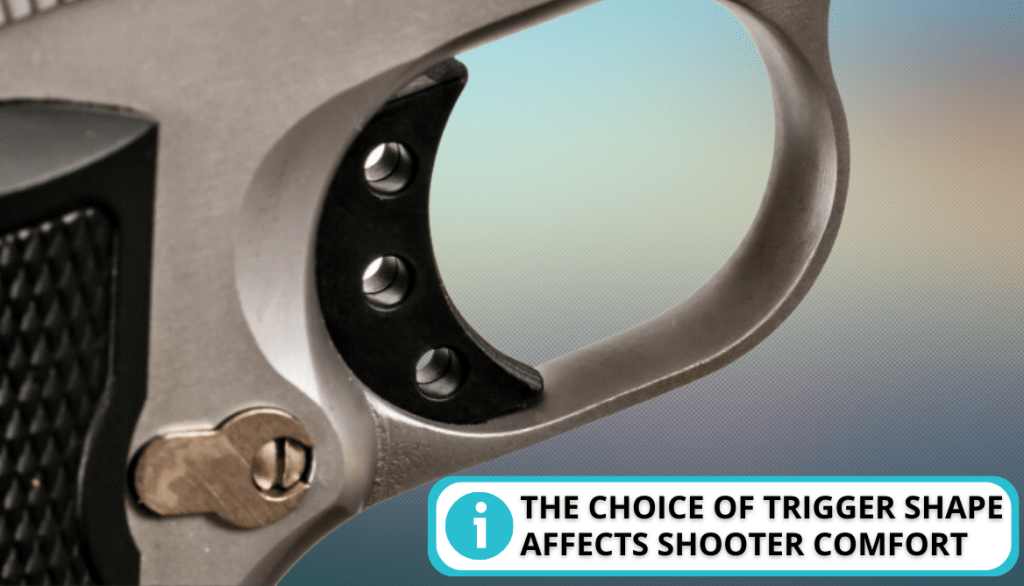
The Trigger features the pull weight, trigger travel, and shape:
- The pull weight: This affects the accuracy, as a heavy or inconsistent trigger pull may inadvertently cause the shooter to move the gun off target during the trigger press.
- The trigger travel: It is the distance the trigger must move before the sear releases the hammer. Shorter trigger travel can contribute to faster and more precise shooting, as there is less distance for the shooter’s finger to travel before the shot breaks.
- Trigger shape: This choice impacts the shooter’s comfort, finger placement, and consistency in the trigger pull. Some shooters find a flat trigger more advantageous for improved finger positioning and a consistent trigger press.
Flat Trigger vs Curved Trigger: Key Similarities
Flat and curved triggers are common variations of triggers found in firearms. While they have some differences, they also share certain vital similarities.
- Function: The flat and curved triggers initiate the firing sequence of a firearm. When pressed, they activate the rifle’s internal mechanisms, allowing you to fire the bullet.
- Basic Design: Both have a lever-like component that extends outward from the firearm’s receiver and a grooved surface to enhance the grip and provide tactile feedback to the shooter.
- Safety Features: Both triggers incorporate various safety features for instance the trigger safeties and the striker blocks. These mechanisms are designed to prevent accidental discharges and ensure the firearm can only be fired when intended.
- Adjustability: The triggers allow for the adjustment of the trigger pull weight, trigger travel, and reset distance. They allow shooters to customize the trigger to their preference.
- Compatibility: Both trigger types are compatible with a wide range of firearms, including pistols, rifles, and shotguns. They can be found in various firearm models and are available as aftermarket upgrades for many popular guns.
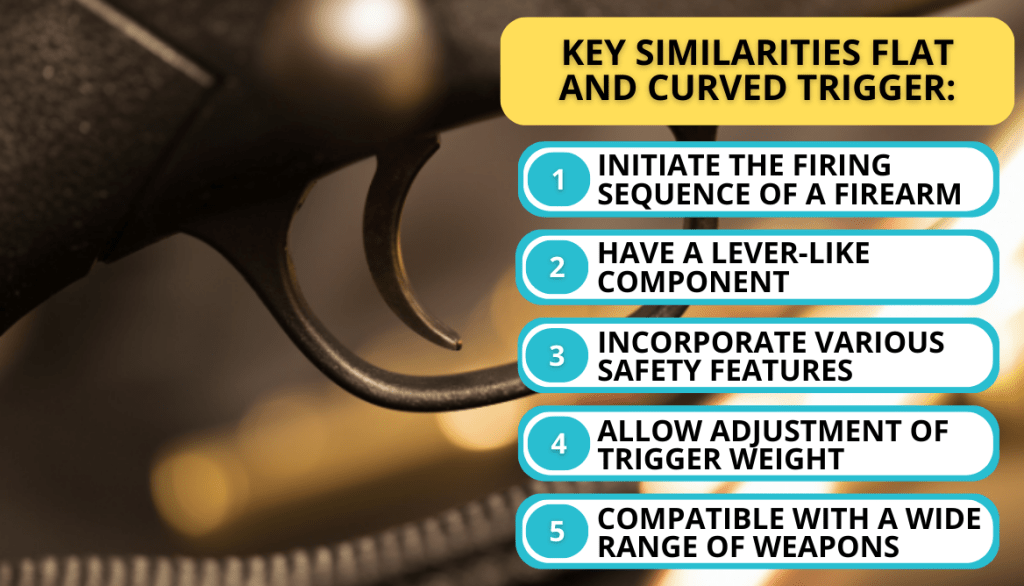
Flat Trigger vs Curved: Unveiling the Distinctive Features
Both triggers have significant differences which vary across different firearms and manufacturers. Let’s check out.
Shape: | Flat trigger | Has a nearly straight surface, resembling a flat plane |
Curved trigger | Has a convex shape, curving inward towards the shooter’s finger | |
Trigger Finger Positioning: | Flat trigger | Shooters using a flat trigger often position their finger pad more towards the center of the trigger, resulting in a straighter trigger pull |
Curved triggers | They tend to guide the shooter’s finger toward the lower part of the trigger, closer to the curved portion | |
Trigger Pull: | Flat triggers | Provide a perceived advantage in the trigger pull. Because the finger moves straight back, there is potentially less lateral movement |
Curved trigger | They offer more lateral movement. This straighter pull may create a crisper and more consistent break, providing a perceived sense of enhanced control | |
Ergonomics: | Flat triggers | They are often associated with a more “modern” or “tactical” aesthetic |
Curved triggers | Are considered more traditional. Some shooters find that a flat trigger provides a more comfortable and natural feel, while others prefer a curved trigger’s familiar and proven ergonomics | |
Availability: | Flat triggers | While growing in popularity, they are still less common and may be found as aftermarket upgrades or specific to certain firearm models |
Curved triggers | They have been the standard design for many years and are present on most firearms |
Range Potential
The trigger’s shape can impact the duration of time it takes for a shooter to engage a target because it affects how smoothly and quickly the shooter can pull it.
- Flat triggers: They allow shooters to exert more leverage, making it easier to pull the trigger. This results in faster target engagement times and improved accuracy since the shooter can easily maintain a consistent trigger pull.
- Curved triggers: They may be more comfortable for particular shooters as they align better with the natural curve of the finger. This ergonomic advantage allows for a more comfortable grip on the firearm, enhancing accuracy and reducing fatigue during extended shooting sessions at long ranges.
Compared to the curved trigger, the flat trigger has a faster range time due to its consistent trigger pull.
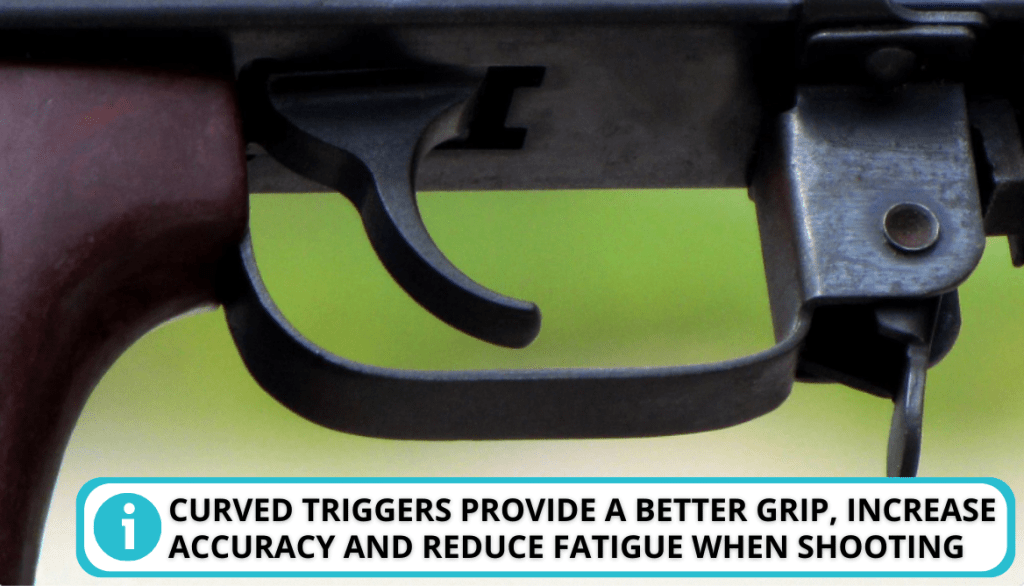
Flat Triggers vs Curved Triggers: Does the Type of Gun Matter?
The type of gun affects the interaction between the trigger and the shooter’s hand and finger placement. Let’s consider both triggers for the pistols and rifles;
Pistols
Flat triggers often have advantages for pistols with shorter trigger pulls. They provide a broader and flatter surface area, offering better finger control.
This leads to improved accuracy and a lighter trigger pull. On the other hand, curved triggers are generally more comfortable for shooters with larger hands and may be preferred for pistols with longer trigger pulls.
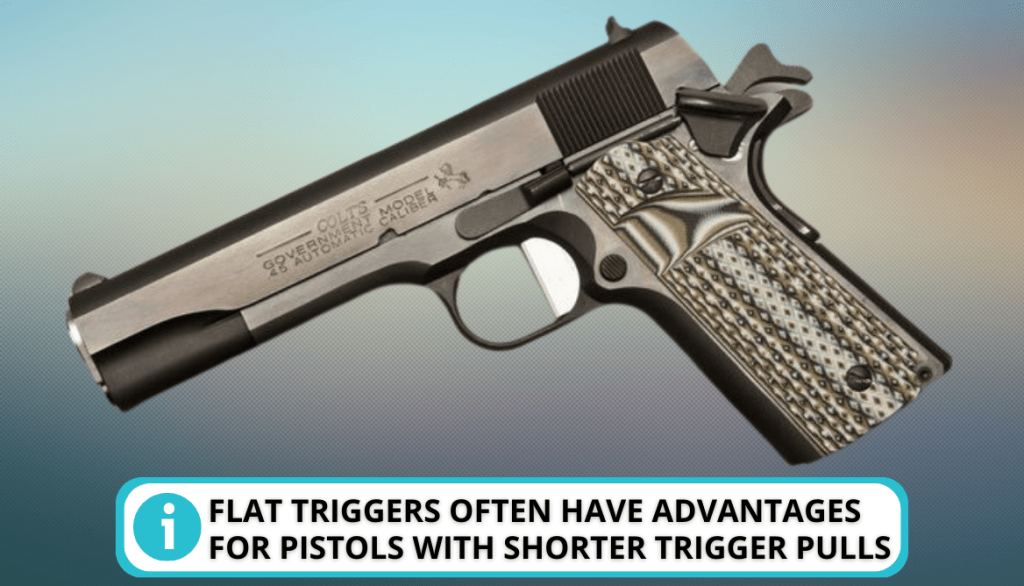
Rifles
Some shooters prefer a curved rifle trigger due to their longer trigger pulls. The curved trigger provides a more natural and comfortable finger placement, promoting a smooth shooting experience.
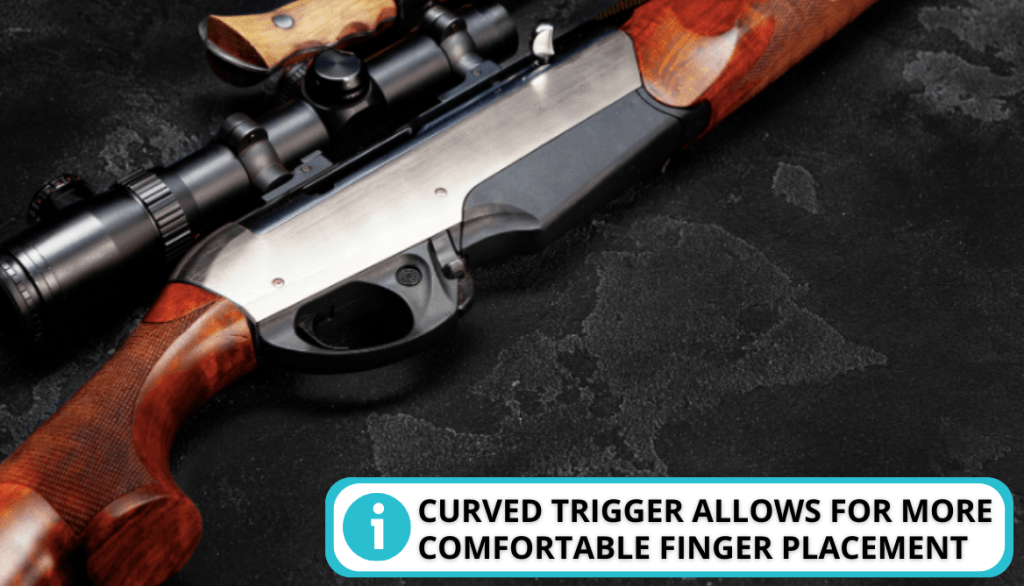
Which is a Better Option?
Some features are unique in both trigger designs. However, both triggers exhibit features differently. We have considered the 5 key features: leverage, mechanical interface, pull weight, variation, and finger placement. In addition to that we have a winner for each section.
1. Leverage
Let’s take a closer look at the leverage of each type:
- Flat triggers: The wider surface area of a flat trigger allows for more even pressure distribution and makes it easier to pull the trigger, especially for shooters with weaker grip strength.
- Curved triggers: The curved design of the trigger provides an increased surface area for the finger to engage. This enables a shooter to apply more even pressure and distribute the force across a wider surface, thereby reducing the likelihood of finger fatigue during extended shooting sessions.
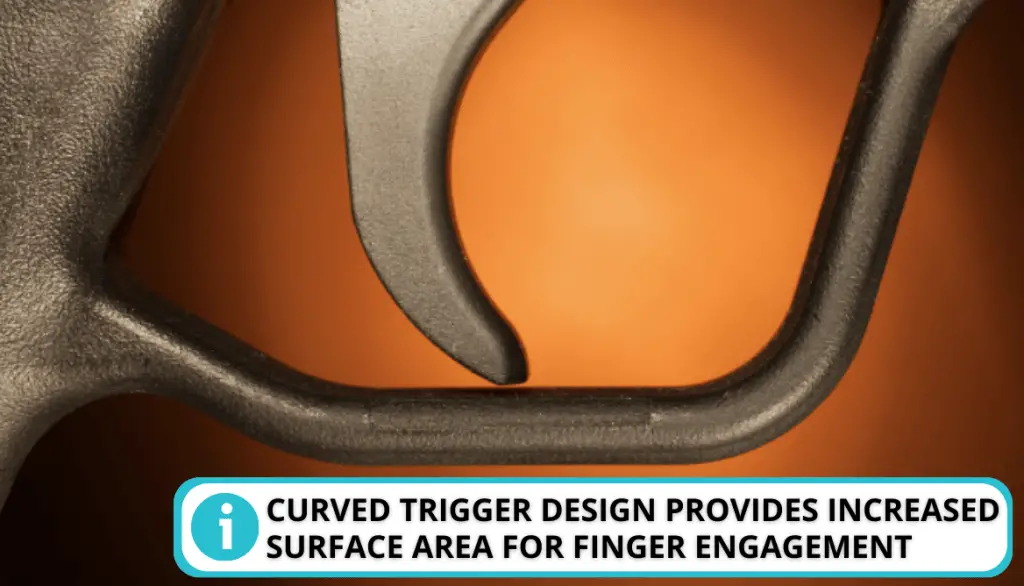
2. Pull Weight and Length
The pull weight refers to the amount of force required to activate the trigger and discharge a round. It plays a crucial role in determining the shooter’s control, accuracy, and overall shooting experience.
- Curved triggers: Curved triggers generally have a long pull length, providing a smoother and more gradual resistance curve. The longer pull allows for better leverage and control, potentially resulting in improved accuracy and comfort.
- Flat triggers: Flat triggers, on the other hand, tend to have a shorter and crisper pull length. The reduced surface area and straighter trigger face can result in a slightly heavier pull weight compared to curved triggers. However, the shorter and more immediate pull can provide distinct tactile feedback and a more responsive trigger break.
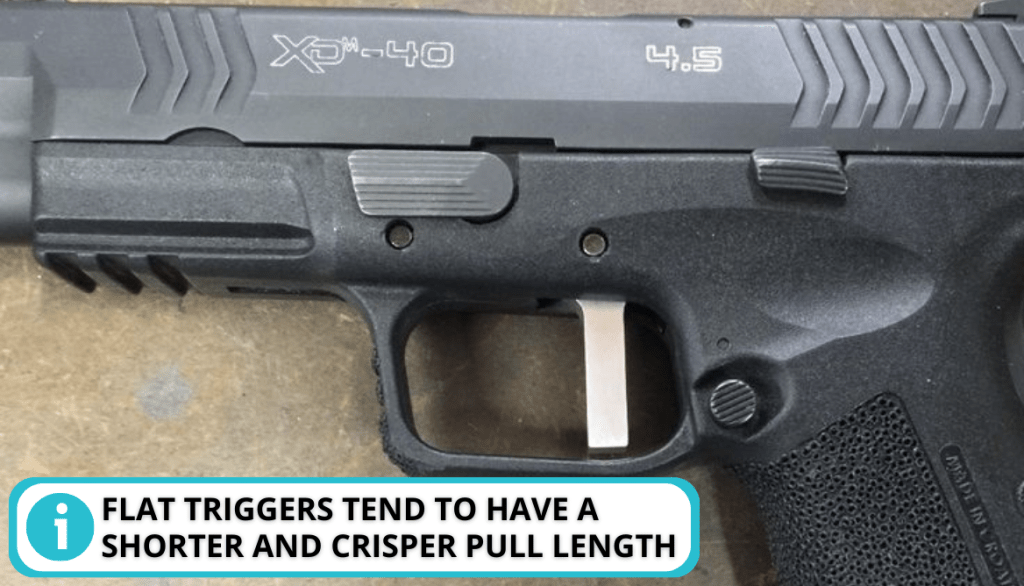
3. Customization
Let’s take a look at the customization of both triggers:
- Curved triggers: They come in various designs with different amounts of curvature, allowing shooters to find the one that best suits their preferences and finger placement.
- Flat triggers: generally have a consistent shape and less variation in design options.
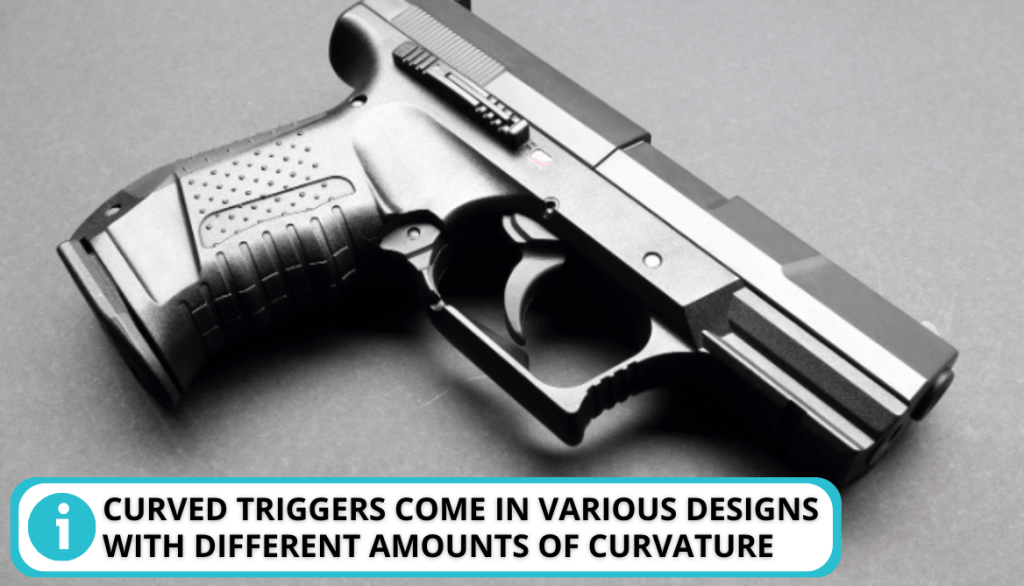
4. Mechanical Interface
The mechanical interface refers to the interaction between the shooter’s finger and the trigger itself. It directly impacts factors such as trigger pull, finger placement, and overall comfort.
- The curved trigger: enables more contact between the trigger’s surface and the shooter’s finger pad, resulting in more consistent finger placement. This increased contact allows for a more comfortable pressure distribution compared to a flat trigger and helps ensure a consistent finger position on the trigger.
- Flat triggers offer a wider surface area that can distribute pressure more evenly across the fingertip, potentially reducing fatigue during extended shooting sessions. They often provide a shorter take-up and crisp break, making them favored by competitive shooters seeking quick and predictable trigger resets.

5. Finger Placement and Hand Size
Finger placement and hand size play a crucial role in determining which design is better suited to an individual shooter.
- Flat Trigger: Designed for shooters with larger hands or those who prefer a straighter trigger pull. They can provide a more consistent and predictable trigger break due to the absence of finger curvature interference.
- Curved trigger: Curved triggers tend to accommodate a wider range of hand sizes and offer a more natural resting position for the finger. They promote a consistent and secure grip by aligning the finger’s natural curve with the trigger’s contour.
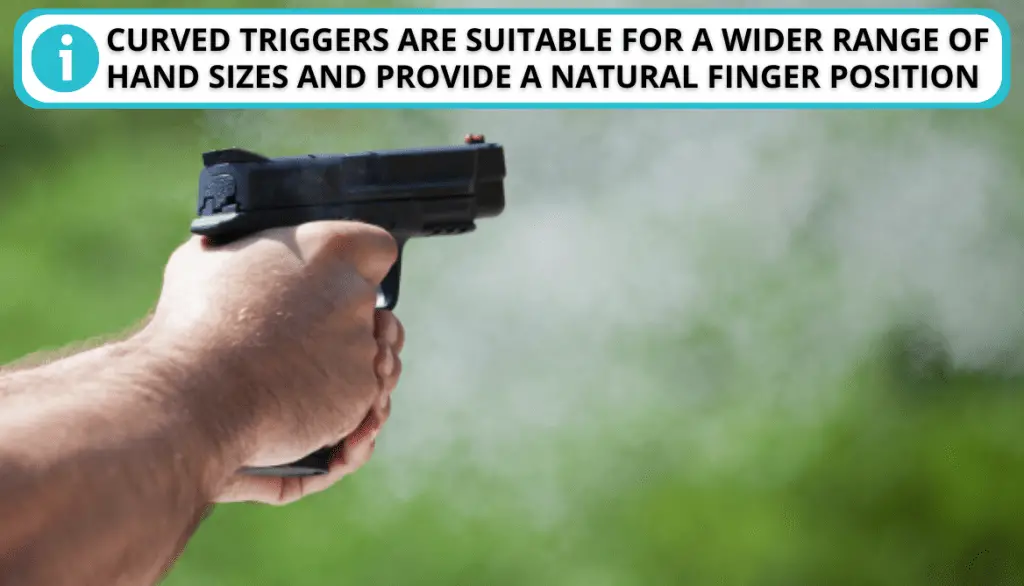
Flat vs Curved Triggers: Pros and Cons
Each of these designs presents its own set of advantages and drawbacks, influencing the shooting experience and overall performance.
Flat Trigger Pros and Cons
Let’s delve into the key benefits and limitations of the flat trigger design.
- It provides a larger surface area for the finger to rest on, promoting comfort and reducing finger fatigue.
- The finger makes uniform contact with a flat trigger blade. With a flat trigger shoe, the trigger reach is the same distance at the bottom and top of the trigger shoe.
- A straight trigger provides a consistent and predictable surface for finger placement, allowing for a more uniform grip and trigger engagement.
- Flat triggers tend to have a shorter reset distance, allowing for quicker follow-up shots.
- Commonly available across a wide range of firearm models, making them accessible and adaptable for various shooting platforms and preferences.
- It may require some adjustment and familiarization for shooters used to traditional curved triggers.
- Some shooters may find flat triggers less comfortable than curved triggers, particularly during extended shooting sessions.
- Reduced safety margin which increases the risk of accidental discharges if proper safety protocols are not followed.
- While flat triggers offer a consistent surface, they may not conform as naturally to the finger’s curvature, potentially affecting the shooter’s overall grip and finger alignment.
- The flat surface may increase the risk of unintended trigger engagement if not correctly handled.
Curved Trigger Pros and Cons
Curved triggers offer a range of advantages that can enhance the shooting experience and performance. However, like any firearm component, curved triggers also come with their own set of drawbacks that may impact certain shooting scenarios.
Let’s delve into the pros and cons of curved triggers to help you make an informed decision when considering this trigger design.
- The curved trigger is common in many firearms, making it familiar to most shooters.
- Curved triggers are designed to conform to the natural curvature of the finger, promoting a comfortable and intuitive grip.
- The curved shape encourages consistent finger placement on the trigger, aiding in precise control and shot placement.
- Curved triggers often have a higher trigger weight and longer pull, reducing the likelihood of accidental discharges.
- It can introduce a slight lateral movement during the trigger pull, affecting shot placement.
- Some shooters with larger hands or specific grip preferences may find it less ergonomic or comfortable.
- Limited surface area may lead to increased finger fatigue during extended shooting sessions.
Curved vs Flat Trigger: The Verdict
So let’s take a look at the final verdict on these two types of triggers:
- Curved Trigger: It stood out as an excellent choice after considering the leverage, mechanical interface, variation, and finger placement. if someone has larger hands and prioritizes comfort, a curved trigger may be an excellent option.
- Flat Trigger: It will offer you an expanded contact area for the finger to rest on, enhancing comfort and alleviating finger exhaustion.
Ultimately, the decision should be based on what feels most comfortable and allows for the best shooting experience for the individual.
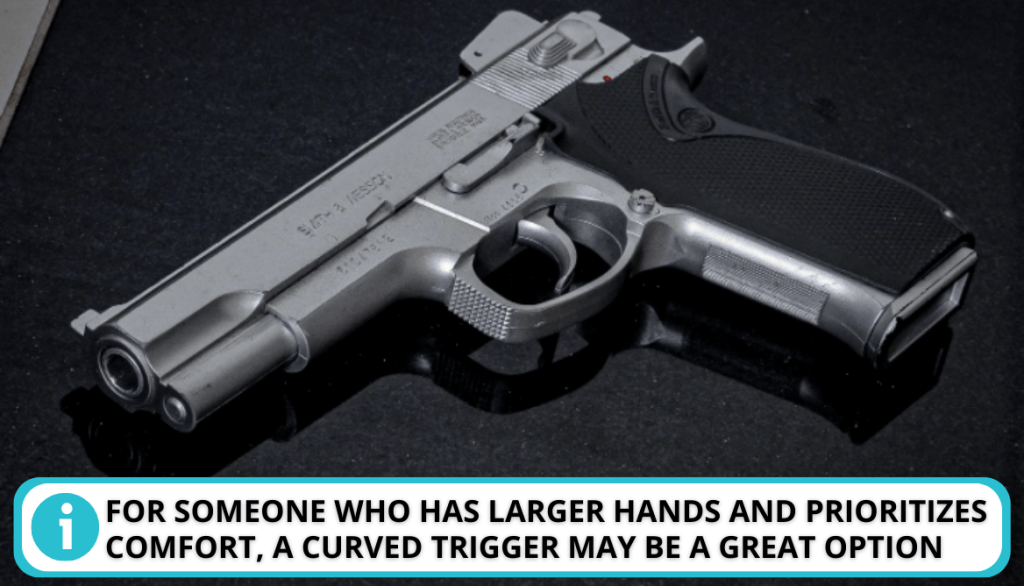
FAQ
Is a flat trigger better than a curved trigger?
A flat trigger might be preferred for precision shooting where a lighter and more consistent trigger pull is desired. While a curved trigger may be favored for self-defense, where speed and quick, intuitive shooting are crucial.
Does a flat trigger matter in the real world?
The flat trigger provides a more consistent and even trigger pull, which can be helpful in situations where accuracy is paramount.
Are curved triggers still available?
Yes, curved triggers are still widely available for firearms. Curved triggers are popular and commonly found in various makes and models. You can check with local gun stores or online retailers to inquire about the availability of curved triggers for specific firearms.
What is the difference between curved and flat-faced triggers?
Flat triggers provide ample space and allow the finger to move toward the lower portion. while, curved triggers have a smaller gap between the finger and the trigger itself, resulting in minimal movement required to adjust the lever arm.
What are the benefits of a flat trigger?
A flat trigger offers a consistent trigger pull with a straight, even surface, which promotes accuracy and precision. Besides this, it allows for consistent finger placement, aiding muscle memory and shot consistency.
Conclusion
The flat and curved trigger have their pros and cons and are useful depending on the situation and personal preference.
A flat trigger will serve you right if you are looking for a consistent pull and potential comfort while the curved trigger will offer a tight grip and an intuitive finger placement.
We recommended that shooters try both designs to determine which feels more natural and enhances their shooting experience. Do you have either of the two designs on your pistol or rifle? Which do you prefer? Leave a comment below.
